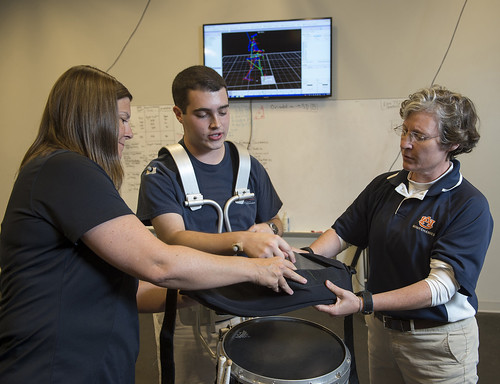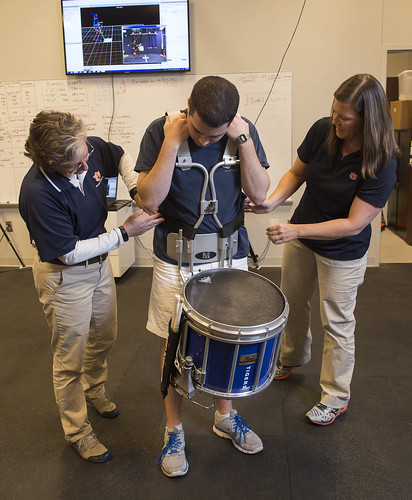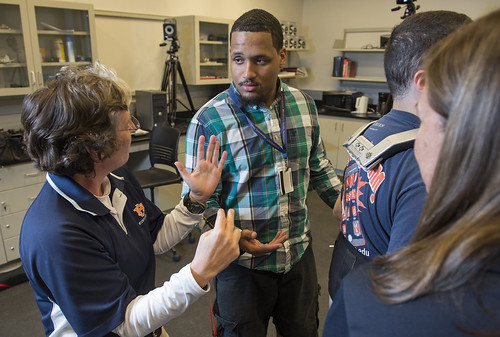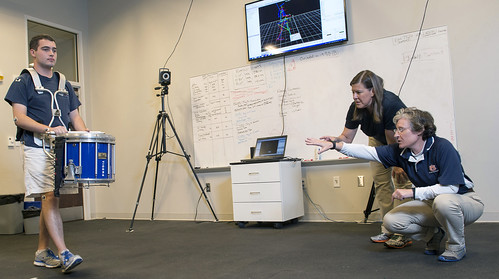Auburn graduate student teams up with fellow Marching Band alumni to invent the Drumbelt
Article body
Marching band drummers may have fewer back pains in the future thanks to a team of Auburn University Marching Band alumni. Ande Sumner, a 2012 graduate of biomechanics in the School of Kinesiology, led the team that invented the Drumbelt, which allows marching band drummers to take greater advantage of the properties of the drum carrier.
Sumner understands the rigors of being a marching athlete, thanks to her experience as a member of the university's Marching Band, where she also served on the medical staff, and her experience as a biomechanist. As a result she hoped to reduce the physical demand on one particular group of the band, the drumline. Based on feedback from the drummers and her knowledge of load carriage, she was able to develop a method of redistributing the load from the drummers' shoulders to other areas of the body better suited for load carriage, in order to relieve their discomfort.
"I wanted to create something that would make performing more enjoyable for the drummers, as well as develop a tool that would hopefully lessen the long term effects of carrying such heavy loads," said Sumner, who is now a physician assistant with the U.S. Air Force. "I did a lot of research, made multiple drawings and then started building and revising my prototypes.
"My experience at Auburn developed me as a researcher; it taught me how to understand the current literature, develop an eye for how things work and be able to see the evolution to the next step. I had an enormous amount of help from great people in multiple departments. It quickly became a campus-wide family project."
Functional prototypes have been produced and a United States non-provisional patent application has been filed for the Drumbelt, which is being used by local high schools.
Fellow Auburn University Marching Band alumnus Yang Zhong, an intern in Auburn's Office of Innovation Advancement and Commercialization, wrote the patent application. "It was obvious to me that Ande's invention had a high potential in the marketplace because of the number of percussionist friends, many of whom suffered from back pains," Zhong said.
He also performed a customer discovery process where he and the inventors spoke to more than 100 potential customers of the Drumbelt to confirm the market, and then used that information to go to conferences to develop interest.
Through this process, he met Russ Gavin, another Auburn band alumnus who is now an assistant professor of music education at Baylor University and corps director of the Blue Stars Drum and Bugle Corps. Quickly seeing the value of the product, Gavin licensed the invention through his company Gavin Brothers LLC.
"I was thrilled the moment I heard about the Drumbelt," said Gavin. "I have been hearing drummers express concerns about back and shoulder discomfort my entire career. The idea that we have a product available that will address those concerns is exciting on several levels. I believe this will become a standard piece of equipment in the marching percussion world."
Sumner also credits the invention to the collaborative efforts of the Department of Kinesiology and Department of Educational Foundations, Leadership and Technology, both in the School of Education; College of Human Sciences; and Department of Music in the College of Liberal Arts.
Sumner's graduate school mentor Wendi Weimar, professor in the School of Kinesiology, and Sara Wolf, associate professor in the Department of Education Foundations, Leadership and Technology, helped Sumner to create and modify the Drumbelt to its current iteration.
"This project was fun and rewarding," Weimar said. "It was wonderful to help Ande grow as a professional and help create a device that would be beneficial to marching athletes."
The benefit of the Drumbelt is that it reduces the pressure at the shoulders, allowing a larger portion of the pressure to be realized at the abdominal plate and the belt.
"After my research in the lab, we were able to test the Drumbelt with snare drummers of the Auburn High School Marching Band and their feedback was better than I expected. The drummers described how much they liked the belt because it made them feel like they were moving with the drum versus the drum bouncing against their bodies. The belt secured the drum and took the load off of their shoulders which they said provided the relief they needed," Sumner said.
She says the Drumbelt has many advantages such as versatility, stability, affordability and durability. The belt is made out of sturdy yet affordable materials and can be sold as an accessory to drum carrier devices for snare, tenor and bass drums. The stability of the belt allows the drum to be held closer to the drummer's body which increases maneuverability. It can be manufactured in many different sizes and has been shown to withstand multiple uses and machine washing.
Wolf described working with Sumner.
"We spent many hours trying to create a belt that would benefit a lot of people. We wanted to come up with a belt that isn't brand specific, is sturdy and washable. A main priority of ours was to create a belt that low-income schools could use. We shared different ideas and created something that fulfilled what we wanted. I know this invention is great and I truly believe in it," Wolf said.
Sumner enjoyed her time with the Auburn University Marching Band, and the Drumbelt has allowed her to give something back to the activity that has given her so much. In addition, she gets to continue her interaction with marching athletes at many levels. Sumner is hopeful that the Drumbelt will allow younger players to stay with the marching music activities longer with less discomfort or injury.
"Everyone I worked with was doing their part to create something that benefitted others and not themselves. No one ever said they were creating this belt to make a profit or make a name for themselves, but rather we all did our job from behind the scenes. The people I worked with helped and supported me the entire time. I had a lot of fun putting this invention together for my dissertation. I never knew it would go this far but I'm extremely humbled it has. The Auburn Family stepped up just like I knew they would. I was a graduate student asking for help and help is what I got. The team I worked with led me in the right direction," she said.
For more information, visit this website or contact Brian Wright, associate director of commercialization in Auburn’s Office of Innovation Advancement and Commercialization, at brian.wright@auburn.edu.
Related Media
Media interested in this story can contact Communications Director Preston Sparks at (334) 844-9999 or preston.sparks@auburn.edu.
Auburn University is a nationally ranked land grant institution recognized for its commitment to world-class scholarship, interdisciplinary research with an elite, top-tier Carnegie R1 classification, life-changing outreach with Carnegie’s Community Engagement designation and an undergraduate education experience second to none. Auburn is home to more than 30,000 students, and its faculty and research partners collaborate to develop and deliver meaningful scholarship, science and technology-based advancements that meet pressing regional, national and global needs. Auburn’s commitment to active student engagement, professional success and public/private partnership drives a growing reputation for outreach and extension that delivers broad economic, health and societal impact.










